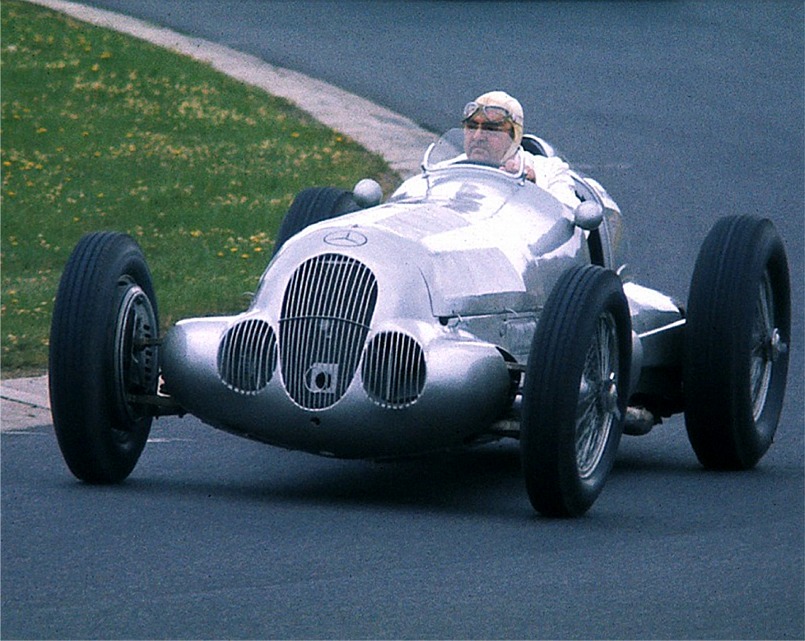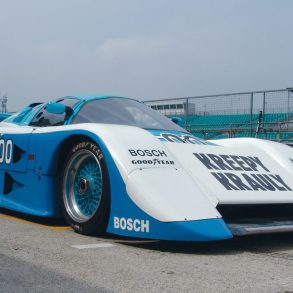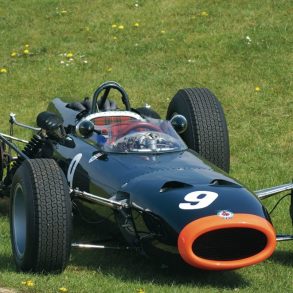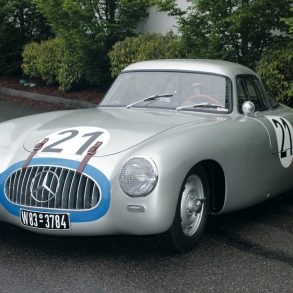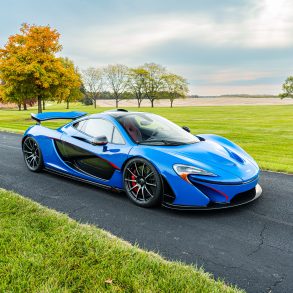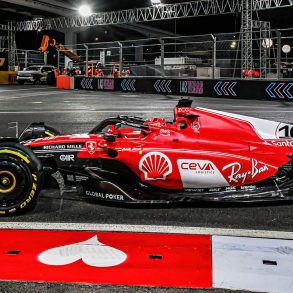The Important People Behind The Silver Arrows
As part of our ongoing series, we take a look at the history of Grand Prix Motor Racing through the lives of its greatest drivers, people and events with a special focus on the history of Formula 1.
Silver Arrows was the nickname given by the press to Germany’s dominant Mercedes-Benz and Auto Union Grand Prix motor racing cars between 1934 and 1939. The name was later applied to the Mercedes-Benz Formula One and sports cars in 1954 and 1955, and currently applied to the Mercedes GP/AMG Petronas Motorsport cars from 2010 to present. Below, we take a look at the key people involved and how they contributed to its remarkable success.
Italo Balbo

He was involved in many bloody attacks against their opponents. By far the bravest of this motley group he came to the attention of the Fascist leadership including Mussolini. When Mussolini came to power Balbo quickly moved up the ladder becoming General and later Marshall. Balbo would have been just another Fascist thug if not for his other great passion, flying.
In fact Balbo was one of Italy’s greatest aviators and accomplished many feats that could not be called anything less than heroic. His most famous feat came during the World’s fair in Chicago in 1933. General Italo Balbo, minister of air under Italy’s dictator Benito Mussolini, led a fleet of 25 Savoia-Marchetti SM.55X flying boats in a mass formation flight to Chicago’s World’s Fair. In an aerial spectacle aimed at demonstrating Italian technological might under fascist rule, Balbo’s 100 crewmen practiced precision formation flying and water landings for months before taking off from Orbetello seaplane base for the first leg of the round-trip transatlantic flight. Despite the loss of a plane and a crewman in Amsterdam, 24 aircraft landed safely on Lake Michigan, having flown 6,065 miles in just under 49 hours flying time. Following celebrations in Chicago and New York, the fleet took off for Rome on July 25. A crash in the Azores took the life of a second crewman, but Balbo’s remaining 23 flying boats arrived home to a patriotic welcome on August 12, still flying in tight formation. Balbo’s popularity rivaled Mussolini’s and as a reward he was banished to Libya as its Governor.
Disillusioned with the direction that Mussolini was taking Italy he resented the growing power of the German Nazi’s over his beloved Italy. Exiled to Libya he assumed the role of Roman pro-consul; the greatness of the empire depended on the prestige the Consul could command. He held lavish receptions replete with African Guards in flowing costumes with drawn swords. The receptions were open to the diplomatic corps of North Africa and international high society. He preferred to mix with the creme of Britain and France over that of Germany. A perfect vehicle for him, in fact his world stage was the Grand Prix of Tripoli. He loved cars and would often cajole the teams to let him try their cars out on the circuit.
On August 13th, 1932 Victor Emmanuel III, King of Italy authorized a lottery based on the result of the Tripoli Grand Prix. The effect was enormous, the race was converted from a backwater event to the top of the Grand Prix calendar. It became known as the race of millions, it also saw it involved in a scandal that rocked the sport when Varzi won the first race during the lottery under dubious circumstances over Nuvolari. The following year Balbo created new rules to prevent any chance of further cheating.
Reality was to intrude on this idyllic setting when Italy entered the war on the side of Germany. Balbo had been against the war from the start. On June 28, 1940 Governor-General Marshal Italo Balbo was shot down and killed by his own AA guns over Tobruk just as an RAF raid materialized (could this have been coincidence? Or is it possible that this was deliberate as Mussolini considered him to be his only serious contender in the fascist “government”.) Considering Hitler’s betrayal of his former comrade Ernst Rölm of the SA this scenario is not an uncommon feature of Fascism.
Elly Beinhorn was born in Hanover in 1907. An only child, she grew up dreaming of travel and adventure in foreign lands. In 1928 she went to a lecture of noted pilot Hauptmann Hermann Köhl. Struck by the lure of flying to distant places she sought to enroll in a flying school. Since none was available in Hanover she travel to Berlin. Both parents were against their young daughter flying so she rented a small room in Spandau and learned to fly at the Berlin-Staaken airfield. Since there were few jobs available for a female pilot she earned a living flying aerobatics but her heart was still in long-distance flying. Her first opportunity to take a longer flight was when her former instructor asked her to fly to Rome and deliver some clothes to a wealthy relative of a flying club member. Dutifully she took off and headed towards Rome guided only by a compass. Unfortunately her first major trip resulted in her getting lost and having to land the plane, finally arriving at her destination aboard a commercial flight 24 hours too late. From this humble beginning her next trip was to Africa with a group of anthropologists. Fort the rest of her life she would have a special affection for Africa. Later flights would take her to the Americas and Asia.
Elly Beinhorn

Elly Beinhorn was already a well known woman aviator when she first met her future husband, Bernd Rosemeyer in 1935. Since 1931 she had flown all over the world and in order to finance her trips she gave lectures. This occasion was a lecture to the local Flying Club in Brno, Czechoslovakia. As a guest of Auto Union she attend the Masaryk Grand Prix being held at the time of her visit to Brno. In the pits she was impressed by a handsome driver, who’s name was Hans Stuck. But this was not Stuck’s race as he suffered what could have been a tragic accident when he was struck in the face by a bird which shattered his goggles. Luckily he was able to mange to return to the pits where he was attended to. The eventual winner was a new rookie driver by the name of Bernd Rosemeyer. Elly was asked by Franz Michler, the Press Officer for Auto Union to go up and congratulate the young winner. One year later on July 13th they were married. To the Nazis they were the perfect Aryan couple and in fact unlike the other drives Rosemeyer was asked to join the SS. Theirs seamed the perfect marriage and the couple became the toast of Berlin. Tragically it was to end not quite three years later with the death of Rosemeyer while on a record attempt.
Alice Caracciola

Alice’s marriage to Alfred Hoffman had been rocky for some time and of course the obvious attraction that his wife had for the dashing Chiron did little to help the situation. At the end of 1932 the marriage was finished and the former Mrs. Hoffman and Louis Chiron became quite a pair. Another young driver with a beautiful companion, in this case his wife, were Rudolf Caracciola and Charly. Caracciola and Chiron had been friends for a while and even became teammates when each was out of a drive, which in Caracciola’s case came when Mercedes temporarily withdrew from racing. Tragedy entered the picture when Caracciola’s wife died in a skiing accident. This occurred while Caracciola was recovering from a terrible accident at Monaco.
Thrown into a deep depression, unwilling to see any one, his friends became very concerned for his mental welfare. Chiron called his friend and stayed with his friend in the immediate aftermath of Charly’s death but it was Baby Hoffman who came to his rescue and helped Caracciola through his mental anguish. They had always been close friends and Charly used to joke that Baby was Rudi’s secret girlfriend. Baby had discussed marriage with Chiron on numerous occasions but he was never able to make that commitment. It might not be idle speculation that given the fact that he had stolen her from another man, made him worry that the same fate awaited him. It did, when Caracciola asked Baby to marry him.
Torn between the two drivers she gave Chiron one last chance. Unaware of his friend’s offer he once again demurred. On June 19, 1937 the former Alice Hoffman became Alice Caracciola. Chiron was furious that his friend would steel “his” woman and it was only much later that his resentment began to mellow. Caracciola had a house built near Lugano overlooking the the lake called Casa Scania and it was there that they would live out the rest of their lives.
Professor Eberan-Eberhorst

These techniques were not used again until the sixties by Chaparral and Ford.In 1938 Auto Union’s racing effort was in deep trouble. Willy Walb was no longer with the team, Hans Stuck had been been sacked, Porsche’s contract had ended and worst of all they lost their star driver, Bernd Rosemeyer. Eberan – Eberhorst was now in charge. A lingering scandal involved Rosemeyer’s crash during a record attempt. Photographs showed what appeared to be dents in the aluminum body with the speculation was that damaged body panels became dislodged and caused the crash.
Professor Eberan-Eberhorst had another car built to the exact same specification and allowed to be photographed by the press. This proved that the so called dents were actually reflections in the aluminum. The next step was to improve the driver line-up and this was accomplished when Nuvolari was finally brought onto the team and with him driving they were able to score some late season victories. Professor Eberan-Eberhorst was duly proud of the effort made by Auto Union which in comparison to Mercedes had only half the budget of its larger rival.
Adolf Hitler

In World War I (1914-1918), Hitler, by then in Munich, volunteered for service in the Bavarian army. He proved a dedicated, courageous soldier, but was never promoted beyond private first class because his superiors thought him lacking in leadership qualities. In 1919 he joined a small fringe party, the National Socialist German Workers’ (Nazi) Party. In November 1923, a time of political and economic chaos, he led an uprising (Putsch) in Munich against the postwar Weimar Republic, proclaiming himself chancellor of a new authoritarian regime. Without military support, however, the Putsch collapsed he ended up in jail. While in jail Hitler wrote his manifesto Mein Kampf (My Struggle). When the Nazi’s gained power he was at their head. After becoming Chancellor he later took the title of President upon the death of Hindenberg. Soon after, a Nazi dominated legislature passed the Enabling Act that permitted Hitler’s government to make laws without the legislature. The act effectively made the legislature powerless. Hitler used the act to Nazify the bureaucracy and the judiciary, replace all labor unions with one Nazi-controlled German Labor Front, and ban all political parties except his own. The economy, the media, and all cultural activities were brought under Nazi authority by making an individual’s livelihood dependent on his or her political loyalty. Thousands of anti-Nazis were taken to concentration camps and all signs of dissent suppressed.
With this as a background the next task for Hitler was to project German might first peacefully and then when ready, militarily. Sports was one area to be exploited and as a self professed motoring enthusiast racing seamed a natural showcase for avowed German superiority. Two German manufacturers, one the inventor of the modern automobile, the other a brand new consortium had independently decided to go racing based on the 1934 formula. The Nazi government, Hitler decided, would sponsor their efforts. Nazi involvement in Grand Prix racing should not diminish the accomplishments of the many talented people as well as drivers that created and drove the Silver Arrows.
Korpsführer Adolf Huhnlein

A humorless man, he was a career soldier who had fought in the first World War. He had new bosses now, the Nazis, and he soon fell into stride. In fact it was said that he made the perfect Nazi lackey. His job appeared to be a dream job for him, that while he had no mechanical qualifications he did have a real love for racing.
He appeared at almost all of the events and it was rare not to see him at full Nazi regalia flittering about with political advise as to who should win or the manner in which the German teams presented themselves. Both teams tried their best to ignore him. Huhnlein, as any good Nazi, was also more than willing to give long speeches on the benefits of National Socialism and it was his duty to prepare a written report after each event to the Führer himself.
Alfred Neubauer

He was a company man who would stay loyal through thick and thin. It soon became apparent to Neubauer as it had been to his wife earlier that he was not destined to become a great race car driver. In fact his wife remarked that he drove like a night watchman! While working for Mercedes he heard of Rudolf Caracciola’s exploits at the first Grand Prix of Germany at Avus in 1926. Caracciola driving under the most appalling conditions was not aware that he had actually won the race. Neubauer believed that a driver on the racetrack was the “world’s loneliest human being.” He thought that if a driver could be informed, during the race, of his position, speed, race distance and other particulars he would have a better chance of achieving his ultimate potential.
With his flags and hand signals Neubauer pioneered many of the techniques that are take for granted today and in so doing this legendary Team Manager left a lasting legacy in automobile racing.
Ilse Pietsc

It all started according to motorsport historian Chris Nixon, the evening of the victory celebration for the 1936 Tripoli Grand Prix. Hans Stuck had been leading the race only to be overtaken in a late charge by Varzi. Unbeknownst to the Italian the results had been arranged by the Nazi officials to appease the Italian Government who held sway over Libya. Varzi was furious when he found out that his victory had been tainted.
Things became worse at the victory dinner when the Governor of Libya, Marshall Balbo proposed a toast to the “real winner”, and raised his glass in the direction of Hans Stuck. At this slight the ever so proud Varzi could take no more and stormed to his hotel room. Ilse was there to console him and it was that night that she introduced him to morphine. Varzi, the perfectionist soon went downhill, a scenario all to common nowadays. The Italian government became so alarmed at the behavior of their champion that upon his return to Italy the way was barred for his mistress, reportedly on the personal instructions of Mussolini. The couple still met when Varzi left Italy only to feed on each other’s addition. Varzi would return to race again and again only to disappear for weeks on end. In March of 1939 Hans Stuck came across Ilse in Munich.
Destitute she asked Stuck for money to purchase a forged Italian passport so that she could get into Italy and be with her lover, who by that time had abandoned her. Later that evening a waiter at Stuck’s hotel informed the German driver of a tragic suicide attempt. Isle had been found unconscious in the street, wearing only a pink nightdress, murmuring a strange Greek-sounding name – Achille. Thankfully she was able to recover from her addiction as was Varzi, both with the help of others. This writer wishes to place no aspirations on either victim for in the end they were both victims to an awful scourge that is still with us today.
Ferdinand Porsche

Ferdinand Porsche’s first mark on the automotive world debuted at the Paris Exposition in 1900. Called the Lohner-Porsche, it was a battery-powered two-seater that used electric motors in the front wheel hubs for the tractive force. The hub motors were designed by the 25 year old Porsche and his employer, Mr. Lohner, boasted to the press: “He is very young, but he is a man with a big career before him. You will hear of him again.”
In 1906, the Austrian branch of the Daimler Motor Co. hired Porsche as its new Technical Director. At Austro-Daimler he pioneered many new designs in engines for airships and “aeroplanes.” Over the next two decades, he designed a number of landmark cars, eventually assuming the position of Chief Engineer at Daimler headquarters in 1923. While at Daimler-Benz, Porsche was also responsible for one of the most sensational motorcars of all time — the Mercedes-Benz S-series. Essentially street-legal racing machines, the great Mercedes-Benz S, SS and SSK models of the late 1920s were bought by gentlemen and sportsmen who wanted speed and comfort. In Hollywood, Zeppo Marx had an SSK, the supercharged version that was especially coveted — just 31 were ever produced. It was in this car that a young driver by the name of Rudolf Caracciola made a name for himself, becoming the first non-Italian to win the Mille Miglia .
At the same time, Dr. Porsche proposed a mass-produced Mercedes-Benz that drivers of modest means could afford, the forerunner for his famous Volkswagen — a radical idea that the Daimler-Benz Board of Directors turned down. Frustrated by the conservative nature of his employer, Porsche quit. As Ferry Porsche, Ferdinand’s son and successor, noted years later: “My father found that when he signed a contract with a firm, they could live another ten years on his designs, but he couldn’t.”
In 1929 he left Mercedes and went to work for Steyr but the Wall Street Crash in October of that year eventually saw him unemployed once again. With financial backing from investors, including Adolf Rosenberger who was a racing driver at Mercedes during Porsche’s employment with the firm he went into business for himself. On March 6th, 1931, Porsche Konstruktionburo für Motoren-Fahrzeug-Luftfahrzeug und Wasserfahrzeugbau was established in Stuttgart, Germany. The firm would specialize in the design of automobile, aircraft and ship engines. Among the employees in this new firm were Porsche’s son Ferry, himself a brilliant engineer and Chief Designer Karl Rabe. Rabe’s contribution has sometimes been overlooked but together with the elder Porsche they formed a formidable duo. One of the first contracts for the newly founded design offices of the Dr. Ing. h. c. F. Porsche GmbH in Stuttgart was a six-cylinder car for Wanderer in Chemnitz (Porsche Type 7) but contracts were few and far between during the depression and soon the new firm was completely broke.
Porsche took this idle time as an opportunity to create a new, high-powered racing engine and attached this new engine to an earlier design for a mid-engined car. When Wanderer joined Audi, DKW and Horch to form Auto Union they turned to Porsche to develop a new racing car for the new 750 Kg Grand Prix Formula of 1934. The head of this new consortium, Baron Klaus von Oertzen arranged a meeting with Adolf Hitler. At the meeting Porsche was able to convince the German leader that supporting Auto Union in addition to Mercedes would be to Germany’s advantage. Thus a brand new company was about to create their first car which happened to be a racing car, one that would rival Mercedes, the inventor of the modern automobile.
Erica Seaman

The dark clouds of war between Germany and England were there for all to see. Seaman was a staunch anti-Nazi but joined the German Mercedes team because they, frankly, were superior to anything that England remotely had to offer at this time. The rift between mother and son became final when Erica became Mrs. Richard Seaman on December 7, 1938. In February of 1939 they attended the Berlin Motor Show. At the show all the Mercedes drivers would meet Adolf Hitler. The night before Seaman mused to his new wife that he would phone the Home Office and say “If I kill Him, (Hitler) will you give a million pounds to my widow.”
Unfortunately for the rest of the world nothing happened the next day. Seaman was unsure whether to stay with Mercedes given the ever worsening political climate but his mentor Earl Howe persuaded him to remain with the team as long as possible. Seaman had always been the junior driver at Mercedes and he began to chafe at his status within the team. He was a very talented driver but his success in England against inferior competition may have driven him to expect too much too soon, at least that was the opinion of some of his teammates at Mercedes. Whether this led him to overextend himself in the wet at Spa in 1939 will never be known. Erica Seaman was of course devastated and spent the night with the Caracciolas.
As a sign of affection for their English driver the heads of Mercedes declared that all of the Mercedes showroom displays would be removed and replace with a memorial portrait of their fallen driver. Mrs. Seaman, Dick’s mother wrote a touching letter to her son’s former bosses thanking them for treating her son so well while he was driving for them. Seaman was the only driver to lose his life driving for Mercedes during this period and his funeral in London was covered all over England. Seaman was not well known while he was driving in England but his appointment to the Mercedes team and his victory in the 1938 German Grand Prix caused a sensation at home. Erica left Germany before the war and came to England and eventually started a new life in the United States.
Rudolf Uhlenhaut

One of the first things that he noticed with the W25 was that there was very little movement of the axle against the frame – much of the springing was done by the frame itself. He quickly grasped that this was completely the opposite of what should happen. Because the suspension was so stiff the wheels couldn’t follow the road. Pictures of the cars jumping at the slightest bump attest to that fact and on one occasion while testing a car a wheel came off at high speed yet the car continued as if nothing had happened!.
For 1937 he worked with the designers to build a car wit a stiff frame and soft suspension. The results were immediate and the Mercedes team was back on top now with Uhlenhaut running the racing department while Neubauer ran the team while at the race. Their partnership would continue with another generation of drivers into the fifties. While Mercedes was not racing Uhlenhaut gained more and more responsibility for new production cars and special projects.
Willy Walb

He was involved in the legendary Benz Tropfenwagen mid-engined car which he also drove in several events. He came to Mercedes when Daimler-Benz was formed and worked under Alfred Neubauer both as a driver and as an assistant Team Manager.
When Auto Union was went racing so did Walb, this time as their team manager. At the end of Auto Union’s first season they held a trial for new drivers. Walb watched as twelve men tried their hand at the Grand Prix car over Nurburgring’s Sudschleife. From these the best six returned the next day and repeated their test, this time on the Nordschleife. Walb selected the two best drivers Paul Pietsch and Bernd Rosemeyer. The latter would turn out to be his last and best decision as team manager. For the 1935 season he was replaced by Dr Karl Feuereissen, formerly of the German Auto Club.


